IoT gateways fulfil several roles in IoT projects. As the number of devices, the scale of IoT projects (and volumes of – heterogeneous – data) and the need for faster intelligence, better security and more integration grows, so does the need for IoT gateways.
IoT gateway shipments will grow to exceed 64 million units in 2021 (ABI Research)
IoT gateways are also important in a context of edge computing. They play a key role in the convergence of IT and OT although not all IoT gateways are the same, let alone have the same capabilities. A strong driver for the growing adoption of IoT gateways is the fact that intelligence shifts to the edge as in many industries existing devices get replaced by their ‘intelligent’ counterparts. As an example of shifts towards the edge: read how that move towards the edge with autonomous decisions by devices is happening in the application of IoT in building management.
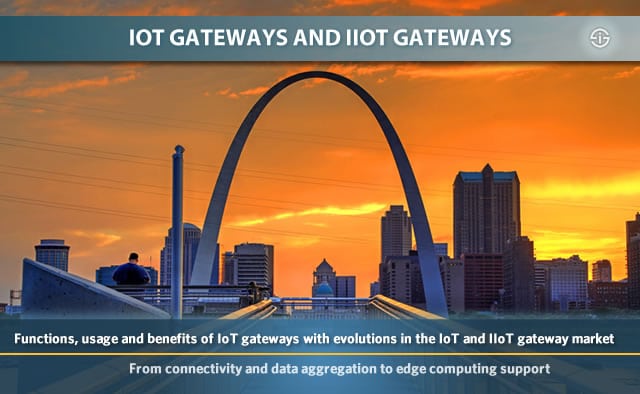
Multi-protocol IoT gateway devices and solutions come in many forms and shapes. Some IoT gateways are designed for vertical usage in areas such as building automation, fleet management and other enterprise IoT environments or for Industrial Internet of Things applications in areas such as maintenance and asset management (remote monitoring) and across industries such as the process industry, manufacturing (IoT in manufacturing and Industry 4.0 overall) or smart grid – where we find the market of the Industrial IoT gateways.
Others are more open and can be easier adapted to specific needs and there are those which are designed for consumer-oriented applications, for instance in home automation. In smaller projects, such as this flood sensor community case, some build their IoT gateways themselves. An overview and some market evolutions for 2018 and beyond.
What are IoT gateways and what role do they play in the IoT technology ecosystem?
IoT gateways are not new but the usage of IoT gateway devices has increased a lot and will continue to do so. At the same time the functions and features of IoT gateways have evolved, whereby they become more important for a broader variety of reasons.
As an example of how many Industrial IoT gateways there can be in major projects: when we covered the launch of Intel Secure Device Onboard at IoT Solutions World Congress 2017 the company said that oil and gas services company Weatherford was part of the pilot program for Intel SDO. In combination with Wind River’s Device Cloud the project could reach a total of nearly 10,000 IoT gateways globally. And we’re not talking about small gateways here.
Anyway, back to IoT gateways, their different flavors, why they are used and why there be more of them in the IoT in 2018 despite being already widely used.
IoT gateways defined
The definition of an IoT gateway has changed over time as the market developed. Just like traditional gateways in networks do, IoT gateways function like bridges – and they bridge a lot.
A high level of interoperability, redundancy, connectivity, pre-processing of data, aggregation of data, remote control and management leads to the requirement for gateways (Nicolas Windpassinger)
The essential definition of an IoT gateway used to revolve around the bridging of the things of the Internet of Things on one hand and the network (routers, base stations and so forth), cloud and/or data center infrastructure on the other.
In an increasingly complex IoT reality with more large scale IoT projects, loads of IoT communication protocols, industrial and IoT standards and many types of sensors and sensor data sitting a bit everywhere (all depending on the scope on the project) a device was and is needed to:
- bridge it all and enable those various things and sensors and data to ‘talk’ with each other (despite speaking a different language) and
- making some sense of it all before sending all this data somewhere else where it really – ideally – leads to real sense, actionable insights and actions in whatever shape.
As Nicolas Windpassinger, author of the brand new IoT book ‘Digitize or Die‘ puts it in a blog post with a slightly different version of the illustration below as an example: IoT gateways bridge things and IoT platforms – and they still do.
Quoting Nicolas: “A high level of interoperability, redundancy, connectivity, pre-processing of data, aggregation of data, remote control and management leads to the requirement for gateways”.
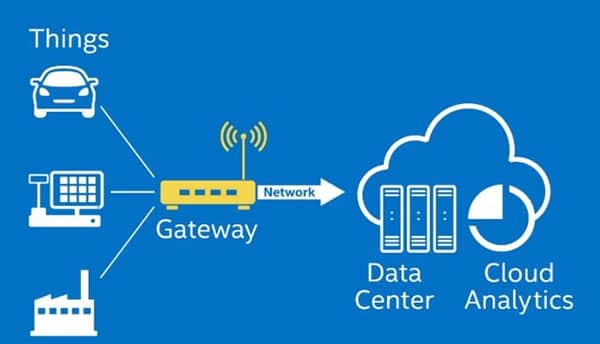
Note: the graphic Nicolas used comes from this gateway page of Intel, one of the larger market players who states that IoT gateways need to enable scalability, manageability, advanced security, performance at the edge and faster, more flexible deployment.
The full IoT technology stack with IoT gateways in it does look a bit more complex and of course the IoT reality continues to change.
Today the IoT gateway is often defined as the bridge between the “full” edge (including the edge systems) and its various components on one hand and the cloud (and business applications or whatever infrastructure where the data goes to/through) on the other. Blame, among others, fog computing and the complexity of what sits on one side and what sits on the other for that (more later).
Why are IoT gateways used?
Below are some of the main reasons why IoT gateways are used. Do keep in mind that there are many types of IoT gateways though.
It’s clear that the reasons why ruggedized industrial IoT gateways are used differ from those why IoT gateways for fleet management or home automation are used (although principles pretty much overlap). It’s also important to realize that within a project many different (types of) gateways can be present, depending on the scope of the project.
Bridging IT and OT with industrial IoT gateways
In order to make the convergence of IT and OT a reality in any given project (and beyond the human and other factors) you need IoT gateways and IoT platforms.
Higher demand for Big Data analytics has led to increased IoT gateway requirements (Technavio)
We’re more in the domain of Industrial IoT gateways and our own favorite topics of Industrial Internet and OT-intensive areas such as building automation and building management systems here but it’s a pretty universal phenomenon: the need for interoperability in areas where there are really many standards, protocols and systems and a lot of operational data to treat in real-time, both in the field or at the network edge as this GlobalSign blog post by Nisarg Desai puts it. We’ll dive a bit deeper into this matter in a separate article but the exact types of IoT gateways of course depend on the purpose, IoT connectivity or communication method, the protocols and standards that need to be supported and thus the data that needs ‘translating’. The OT standards and protocols in manufacturing processes are not the same as in some areas of building automation (although, again, there are always overlaps). And you can imagine that in a heavy industrial outdoor context you have different needs on the levels of communication components, processing power and sheer strength than in your average smart home automation context.
Complex IoT projects with edge computing
Mainly in Industrial IoT there is an increasing movement towards the edge as is the case in many technologies.
With fog computing (and the movement to the edge overall) we really enter the space of what is now known as an intelligent IoT gateway. Whereas in the initial and more simple picture an IoT gateway sat between the sensors, devices and so forth on one hand and the cloud on the other, a lot of analytics and filtering of information is now increasingly done closer to the sensors through fog nodes for myriad possible reasons as explained in our article on fog computing. The illustration below shows where the intelligent IoT gateway (and soon they’ll all be intelligent) sits here. That illustration by the way comes from the TPC (Transaction Processing Performance Council) which announced its TPCx-IoT Benchmark, a benchmark for IoT gateways, end September 2017.
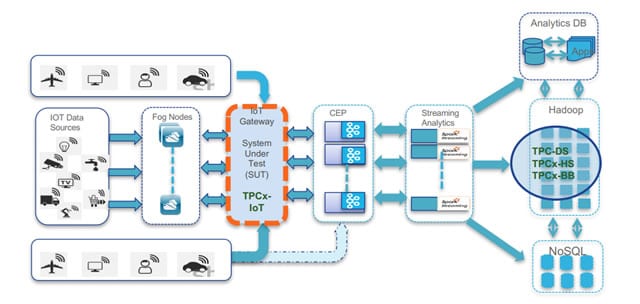
Quote from the TPCx-IoT page: “TPCx-IoT, the industry’s first benchmark which enables direct comparison of different software and hardware solutions for IoT gateways. Positioned between edge architecture and the back-end data center, gateway systems perform functions such as data aggregation, real-time analytics and persistent storage.”
We mentioned analytics before, do note the storage aspect and the software dimension. It’s clear that IoT gateways also come with software, can be virtual to begin with and need to be able to connect with IoT operating systems.
You can read more about TPC, its members (Intel is there as are, among others, HP Enterprise, Cisco, Dell, Fujitsu, Microsoft, IBM, redhat, Oracle, vmware, Huawei, Pivotal and more players in the big IoT technology landscape including IoT gateways and IoT platforms), TPCx-IoT and more in this PDF document.
IoT gateways and security
A third important reason why IoT gateways are used has everything to do with security on the level of communications.
When ABI Research announced that the number of IoT gateway shipments would exceed 64 million units in 2021, the research firm stated that, quote, “home automation and security market components will account for well over 50%”. Among the reason why IoT gateways are important for security: the sensors and devices get connected to IoT gateways, which in turn, after the necessary translating and processing send everything that is needed to the cloud or data center. So, less devices get directly connected to the big bad outside world but there is also more security required on the level of the IoT gateway which indeed is connected to that big bad outside world which we call the Internet (of Things). The previously mentioned blog post on the website of Globalsign explains it better than we ever could and looks at the IT and OT part but really covers the security aspects very well in all regards (including what to watch for when buying an IoT gateway, among others from the security perspective, but also how to secure an IoT gateway, among others). There is quite some encryption and decryption going on in IoT gateways.
Other applications
Do note that this list of reasons is not exhaustive. Main functions still remain the enablement of data and connectivity aggregation, the connection of new IoT devices (or legacy devices) to the network, the translation of IT, OT and IoT protocols, IoT device management etc. (more below).
What types of data, protocols and connectivity are involved depends on use case and thus type of IoT gateway. An example: an IoT gateway for fleet management needs to be able to ‘communicate’ with telematics systems and their specific protocols, as well as with GPS.
Evolutions: findings about the IoT gateway and industrial IoT gateway markets
Let’s take a look at the market of IoT gateways. In the previously mentioned research by ABI, where IoT gateways are described as devices which manage and control complex connected environments by aggregating and transmitting sensor data, as well as translating communication protocols, strong growth was predicted.
The overall IoT gateway market
While, as said home automation and security market components would account for over half of shipments in the period until 2021, most revenue is generated in the segments of mobility and transportation and of industry and infrastructure (we’re also talking about more expensive devices here).
In the growing IoT gateway market, consolidation is not expected anytime soon and suppliers are increasingly turning to software and services to differentiate (ABI Research)
Quoting Dan Shey of ABI Research: “The home automation and security market relies on gateways for aggregating and orchestrating communications between an increasing variety of home sensors and cloud services. However, this segment will only represent around 30% of the market’s five-year value”.
The reason? IoT gateways in industrial and enterprise/commercial settings have different requirements regarding ruggedness, antenna design, and processor requirements. And that of course comes with a higher cost. So: less volume, more revenue.
ABI Research mainly sees opportunities in the mentioned segments but also in fleet management they are growing. On the industrial and infrastructure IoT gateway market level we note smart grid, video surveillance and increasingly smart city applications and manufacturing and process industries.
The Industrial IoT gateway market
In the Spring of 2017 Technavio specifically looked at the market of Industrial IoT gateways, forecasting the market to grow at a Compound Annual Growth Rate (CAGR) of more or less 15 percent until 2021.
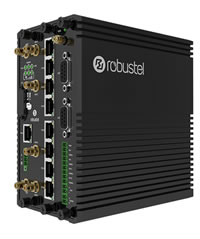
Taking into account that from and IoT spending and investment perspective industrial markets, with manufacturing, transportation and utilities at the top, are still leading the way and already having quite some IoT projects that two-digit CAGR isn’t bad at all.
Technavio expects the worldwide industrial IoT gateway market to reach a total value of USD 1,390.2 million by 2021. The company defines an IoT gateway as a “switching device used for aggregating, filtering, and processing sensor data by providing a highly secure platform.”
In the industrial IoT gateway market which Technavio analyzed the process industry is by far the largest end customer of industrial IoT gateways with over 68 percent of the market.
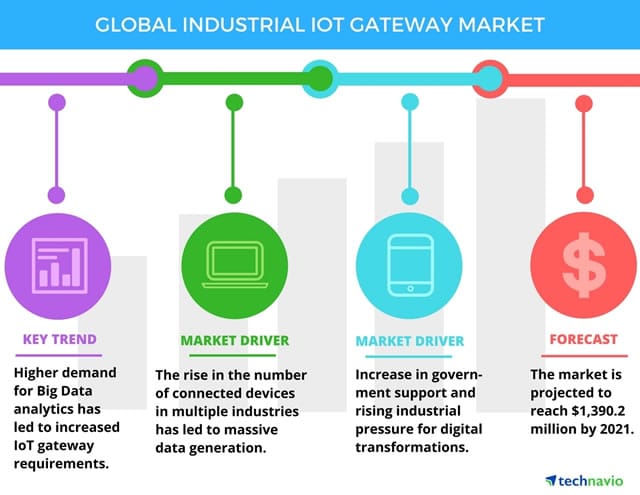
Among the many takeaways from the report as cited in the press release (and of which some are depicted in the graphic below):
- On an IoT connectivity level there has been a shift from wired to wireless connections in industrial gateways. This is – obviously – fully in line with the increasing use of wireless IoT technologies in industrial settings.
- The growth of the industrial IoT gateway market is, among others, driven by an increased amount of data in industrial IoT and higher demand for Big Data analytics as mentioned in the introduction.
- End customers mainly seek cost reduction, quality enhancement and product differentiation.
- Technical advancements of industrial IoT gateways, among others in terms of connectivity, performance, costs and miniaturization also contribute to higher demand for industrial IoT gateways.
- Industrial IoT gateways are found to boost enterprise mobility, remote monitoring, secure data exchange, data consolidation and remote system control.
Although the announcement doesn’t explicitly mention changes in the IoT ecosystem towards the IoT edge and fog computing, increasing demand for Big Data analytics in industrial IoT de facto translates in a key role for IoT gateways in this changing IoT environment.
On the sampe page of the report (where you can also buy it), which looks at the industrial IoT gateway market from the perspective of 1) geography, 2) applications (remote monitoring, preventive maintenance, and product optimization) and the end customer (process industry, as said by far number one, and discrete industry) Technavio states that the US will be the fastest growing market for Industrial IoT gateways, among others because of higher cloud computing adoption and the existing mobile network infrastructure.
The demand for smart meters in the energy and utility industries is expected to lead to growing demand for IoT gateways as well, Technavio states. The report looks at some vendors in the Industrial IoT gateway space such as AEON, ADLINK, Advantech, Cisco, Dell, Eurotech, Hewlett Packard Enterprise, Huawei, Lantronix and Siemens.
The main function of the IoT gateway
More recent research clearly emphasizes the role of fog computing. In an article on the role of IoT gateways in the network, Shamus McGillicuddy of EMA, wrote about some findings from EMA’s report “The Internet of Things and Enterprise Networks: Planning, Engineering, and Operational Strategies“.
According to McGillicuddy 72 percent of network infrastructure professionals with a role in of IoT projects deployed IoT gateways within their environment (note: this isn’t just industrial IoT gateways).
Multi-protocol gateways enable standardization, IoT protocol translation, IoT device control, IoT data encryption, connectivity aggregation and support of edge computing
A few interesting findings are that only 40 percent of respondents use them for connectivity aggregation and that the main function for IoT gateways – de facto – goes to the support of edge computing and analytics with 57 percent.
Some other takeaways:
- 50 percent of IoT gateway users also leverage the devices to encrypt/decrypt IoT data.
- 47 percent of organizations implements IoT device control and management on gateways.
- 43 percent implements IoT protocol translation.
A final note on IoT gateways
Is this all? Not at all. We can also talk about IoT gateways and battery life, IoT gateways and IPv6, the dozens of standards and protocols on the technology layers where IoT gateways fit (connectivity protocols, myriad standards depending on context), provide examples of IoT gateways in areas such as fleet management, home automation and industrial IoT, sum up the main vendors and products, dive deeper in how it all works etc.
However, for now we’ll end with some words from Nicolas Windpassinger, as previously mentioned author of an IoT book for digital transformation leaders:
Regardless of the standard, IoT Things that make the jump from main power to running for months on batteries will need a gateway to provide:
- communication to the cloud and the IoT platforms
- specific applications / functions not delivered by the IoT Things endpoints
- protocol conversion
- local decision making
- local management and accessibility for users
- local pre-processed filtering and aggregation of data
- local additional processing power and storage
- local security
Top image: Shutterstock – Copyright: STLJB – All other images are the property of their respective mentioned owners.

